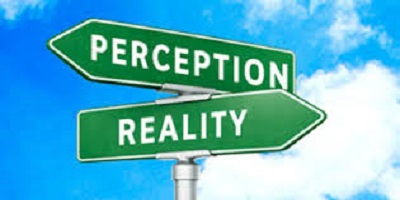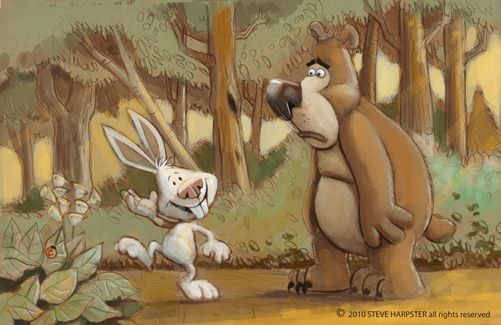Reason and Emotion: The Children of Desire - Part VI
Here's Part VI of my essay about Reason and Emotion - how they differ, and how they are related. If you're just arriving, I encourage you to read the earlier parts where I go through the history and definitions of some of the key concepts: Part I | Part II | Part III | Part IV | Part V

Source


Still, it must be remembered that these super calculators are finite and fallible. The neuroscientist V.S. Ramachandran writes the following about perception in general, but it can just as easily apply to our discussion of emotions: “The single most important principle underlying all of perception [is this] – that the mechanisms of perception are mainly involved in extracting statistical correlations from the world to create a model that is temporarily useful.” Our senses have developed in order that we may interact with that part of the world that is useful to us; they did not necessarily develop in accordance to the way the world “really” is. Just so with emotions and feelings. We have developed a range of feelings that, up to this evolutionary point, have most efficiently interacted with our perception of the world in which we live. But since the world is ever-changing, so must be our ability to interact with it.

Source
Human beings are usually conscious of their feeling state, but they are rarely conscious of all the reasons and causes of that state. I think it likely that, since feelings and consciousness seem to have developed over parallel periods of time, the calculations that go into creating a feeling state can never be brought fully to the surface of awareness. Things get more complicated when we realize that multiple stimuli are causing various and simultaneous emotional responses, and that the conscious feelings that we experience are likely sums of many different emotional responses. Consider the extreme (and imaginary) example of the adolescent boy having great sex with his older girlfriend. Just as he is about to climax, he hears a terrifying shriek from the second floor of the house, and, looking out the window, he witnesses his beloved mother plunging to her death from above. Here are two very potent emotional stimuli interacting in his brain at once – one of great good, and one of great evil. Later on in his adult life he may find that death for him is a great sexual stimulant (or sex in general is a fearful thing). The reason for this is that he could not sift through the exterior stimuli that had once caused his contradictory internal emotions. This is an example of an extreme situation, and it is likely that a normal person could, with counseling, separate these stimuli from each other and achieve a more healthy sexual appetite. But now consider the multitude of emotional stimuli that bombard us all day long. These little bits of value judgment ever shape our emotional state, and their very number and innocuousness makes it impossible to separate them all and find a precise reason for the said emotional state. The fact that feelings develop in the subconscious leads to problems and fallibility.
Another problem with emotions and feelings is their strong anchor in biologic necessity. The world is always changing, and so is Man. As an example, some scientists believe that primates have a genetic predisposition to fear snakes. When homo sapiens was out running and hunting barefoot in the wild, a healthy fear of snakes was probably a good thing to have.

Source
But now, in this age of homes and sneakers, such a fear seems rather superfluous, if not debilitating. The genetic fear of snakes can be compared to the biblical command not to eat pork – perhaps important in the day it was written, but now it has no use. As Daniel Dennett suggests, “What is nonsense is the idea that what Mother Nature intends is ipso facto good (for us now).” One's emotional state is not only a result of the current environmental stimuli in one's vicinity and the events and experiences of one's past, but it is also affected by one's genetic inheritance. Too often this biologic baggage no longer corresponds to the world of the present, and we must, like the snake charmer overcoming his fear, outreach our past and embrace the future.
Thus we see that emotion – both emotion-proper and feelings – is an invaluable tool for one's survival. Emotion helps people categorize experiences and calculate value. But, like all tools, it is fallible and incomplete. Here in the evolutionary growth of emotion is found both the need for, and the foundation of, the development of reason. In the next section, I will try to show how conscious reason has solved some of the problems left over by emotion, as well as what further problems still remain.


Unlike the mythic birth of Athena, reason did not spring forth from the head of man full-grown and fully armored. Emotion had laid the foundation for rational thought long before anyone came up with the first syllogism. The idea that emotions are basically rational is not new. Antonio Damasio suggests that both Aristotle and Spinoza thought that at least some emotions were rational, and to a lesser extent so did David Hume and Adam Smith. He goes on to say that, “In this context, the term rational does not denote explicit logical reasoning but rather an association with actions or outcomes that are beneficial to the organism exhibiting emotions.” As we have already seen, emotions are reactions to exterior, value-laden stimuli. For the young man with the tragic first sexual experience, he associates death in general, not just the death of his mother, with later sexual gratification. This suggests that the capacity for association is already inherent in our emotions. So too with the rabbit who has had a past run-in with a hungry bear and has sustained a claw wound from the experience. The rabbit will likely fear later meetings with different bears. Even without consciousness the rabbit is making a judgment of contiguity and association: this approaching object is very much like the bear-y object that hurt me once before; and, since it is a similar object acting in a similar circumstance, it will likely try to eat me like that other bear-y object. Cause – the appearance of a hungry bear. Effect – it will likely try to eat me. Because the rabbit can make such a judgment, it will try to run away from the bear, and it has a better chance to live longer and reproduce more. The rabbit's emotion of fear causes a beneficial action.

Source
Friedrich Nietzsche, the nineteenth century German philosopher, suggests that reason and logic first came into existence due to this very illogical process, this “...tendency to treat as equal what is merely similar”. He means that everything in existence is individualistic, and that man's ability to form concepts through associations of equality is a handicap to seeing the Truth. “The beings that did not see so precisely had an advantage over those that saw everything 'in flux'.” Here Nietzsche is speaking specifically about man, but I would suggest that the same could be applied to much of the animal kingdom. If this is so, what makes man so special? How is it that the species homo sapiens is so often described in essence as being “rational”, whereas the rest of the beasts of the earth are not?
The writing of this essay has forced me to a conclusion which I could not have imagined before I started doing my research. I now have to admit that the difference in reasoning ability between man and beast is one of degree rather than kind. Man's reason is like an explosive, armor-piercing bullet, as compared to the lower animals' rough-hewn spears; and yet, in essence they are both projectiles, they are both tools meant for the same end. The thing that makes man's reason so much sharper than that of his ancestors is his consciousness, his sense of self.
Once again, the hallmark of life is value. Plants are store-houses of value. They cycle through life, absorbing water and sunlight, creating their own sustenance. Their purpose is living. The amoeba, despite its lack of consciousness and complexity, spends its whole life in search of value. It devours the little one-celled plants in its vicinity with its life as its sole purpose. With the evolution of movement and perception at a distance, the first great technological animal advance appears: emotion. Hard-wired biological processes form to aid an organism in seeking and protecting value. The next great technological advance is the appearance of feelings, and with that, consciousness. Finally there is a unified self, aware of itself, aware of the concept value. It is this knowing self that supplies the power of conscious appetite; and it is this knowing self that lays the foundation for conscious, rational thought, the most efficacious tool yet acquired by life on earth.

For homo sapiens, reasoning is a deliberative process that requires consciousness. As stated earlier, I agree with Antonio Damasio when he describes emotions and feelings as basically “rational” or “reasonable”, in the sense that emotions have evolved and exist because they achieve an organism's ends. But, in this sense, emotions are not “rational” enough. Multiple emotions are too often in conflict with one another, and this conflict is possible because our differing emotions are affected by different and often simultaneous body states. By forming under the radar of consciousness, emotions can often feel like an unknowable chaos.

Source
But it is consciousness that allows for order and singularity. It is consciousness, with the help of reason, that can examine the often warring emotional/body states and decide which is the more important and valuable. Daniel Dennett decries the notion of consciousness as a single, dimensionless viewpoint locked somewhere in the brain; he instead proposes a Multiple Drafts theory where separate but cooperative areas of the brain work together to solve problems and form thoughts. Yet still our experience of consciousness is like a bottle-neck placed over the vast underpinnings of this Multiple Drafts model. We can only examine information that comes up through that bottle-neck. While the brain continues to sort and refine ideas and information below the surface of consciousness, we use the deliberative process of reasoning at the forefront of consciousness to examine that data that the brain has already pre-sorted. Here the Self – that fictional construct of the will whose unity makes the search for value feel so important – makes the final comparison in order to decide which means is the most efficient to achieving which end.
But in order to make this final judgment we must also have a means to express meaning, and language supplies that means. Language is the ability to not only form concepts, but to be able to communicate those concepts and meanings to like-minded brothers. Once again we see that the foundations for this new tool were laid well before we evolved into human beings. The rabbit who compares two objects and decides that they both fall under the heading “bear”, or simply “big, dangerous object”, is forming a primitive concept . And many of the physiological responses brought on by emotion are means of communicating to other animals, like the dog tucking tail and whimpering to the other side of the yard in fear, advertising the presence of a possible predator. But for whatever reason, conscious man was one day able to bring forth those internal “primitive concepts” out of his mind and into the world in the form of words. And as his language skills became more efficient and complex, so did his reasoning power.

Source
V.S. Ramachandran writes, “All our perceptions – indeed, maybe all aspects of our minds – are governed by comparisons and not by absolute values.” Reason is one of the tools by which we make these comparisons. While our perceptions and emotions continually give us evidence by which to make our judgments, this evidence usually remains below the surface of consciousness. When reason develops, however, this comparative process is no longer limited to the comparison between exterior stimuli and events. With reason, that most important object of consciousness - Self - can be juxtaposed to the exterior objects of the world and the consequences that they imply. The Self is the most important object present to human consciousness.
It is our perception of the Self that defines how we classify and rank the objects of the world. All perception is relational, and it is impossible to perceive only one object. Perception is always a juxtaposition between the multitude of existence. But, at bottom, reason can be nothing more than the perception of a relationship between the Self and Other. Reason is a conscious calculator of value, and it is this consciousness that makes reason humanity's most adaptive tool.

Okay - that's it for Part VI. We've almost reached the conclusion! You can find Part VII (conclusion) HERE.
If you found this post interesting and/or useful, I certainly appreciate all upvotes and follows. And I'd love to continue the conversation in the comments below. Thanks for reading
References
- Damasio, Antonio. (2003). Looking for Spinoza: Joy, Sorrow, and the Feeling Brain. New York: Harcourt, Inc.
- Dennett, Daniel. (1991). Consciousness Explained. Boston: Back Bay Books.
- Nietzsche, Frederich. (1882). The Gay Science. Trans. Walter Kaufmann. New York: Vintage Books, 1974.
- Ramachandran, V.S., Blakeslee, Sandra. (1998). Phantoms in the Brain. New York: Quill Publications.

Congratulations @jpgaltmiller! You have completed some achievement on Steemit and have been rewarded with new badge(s) :
Click on any badge to view your own Board of Honor on SteemitBoard.
For more information about SteemitBoard, click here
If you no longer want to receive notifications, reply to this comment with the word
STOPLanguage is the ability to not only form concepts, but to be able to communicate those concepts and meanings to like-minded brothers. Once again we see that the foundations for this new tool were laid well before we evolved into human beings. The rabbit who compares two objects and decides that they both fall under the heading “bear”, or simply “big, dangerous object”, is forming a primitive concept .
Fascinating!
Thank you for this thoughtful and insightful series.